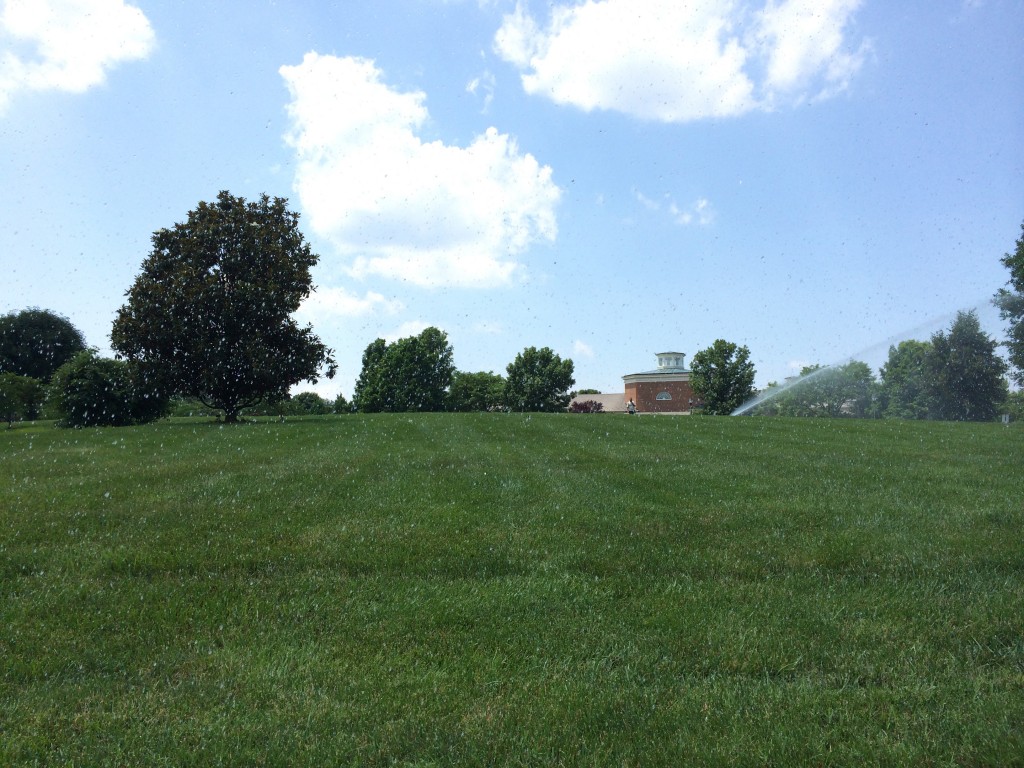Smart Watering
A waterwise garden works with nature and natural forces (like rain) to hydrate plants while conserving water. Reducing the need to water your garden requires a little bit of research and some planning, but we think you’ll find the investment worthwhile. If you don’t already have a rain barrel installed, not only will you be saving on your water bill each month, but you’ll be helping the environment too. With two reasons to save, we hope you’ll try these watersaving tips!

Watersaving tip: Run your sprinkler in the early morning will help you save money and help the environment too.
First of all, try to limit the overall amount of water you are using. While the total amount you water is dependent on many factors such as weather, soil type, type of plants, etc, the general rule is that watering more deeply less often (say 2 times per week) promotes stronger, deeper root growth and more resilient plants. Also, you don’t want to water if your plants don’t really need it, so it’s a good idea to invest in a rain gauge so you can see how much water they are getting from natural sources.
You’ll want to make sure you are watering early in the morning for two reasons. First, wet foliage at night can promote a host of plant diseases, especially fungal ones. Watering in the morning ensures foliage has time to dry before nightfall. Secondly, evaporation rates are lower when the sun is lower in the sky – you lose less water to evaporation if you water in the early morning.
For most efficient watering it’s best to hand water rather than setting up a sprinkler. Water gets exactly where you want it and you can see and control how much is delivered. Another option is a soaker hose that slowly drips water out just at the soil surface where you lay the hose. If you do end up having to use a sprinkler, but sure to avoid ones that shoot water high in the air. Significant evaporation losses happen by the time water droplets shoot up and fall all the way back down. Also, make sure that your sprinklers are adjustable so that you don’t end up watering the pavement.
Watersaving Tips
Here are a few more watersaving tips from Lewis Ginter Botanical Garden Senior Horticulturist Elizabeth Fogel. It’s worthwhile to invest in a watering nozzle with a good shut-off valve that gives you the ability to let you turn off the water, or adjust the flow, away from the spigot. You don’t need a complicated multi-setting one. Just something simple. A simple watering nozzle is less likely to break with fewer parts. If your hose is leaky try adding rubber washers and using silicone tape to prevent leaky connections. You’ll keep your shoes dry and waste less water!
Did you know?
Did you know that xeriscaping, or xeriscape landscaping, are terms often used interchangeably with waterwise gardening? The word “xeriscape” is derived from the Greek xēros, meaning “dry,” and the word “landscape.” The Denver Water Department coined and copyrighted the term in an effort to make water-efficient landscaping an easily recognizable and catchy concept. If you plant the right plants (think natives), then they’ll need less water.
The 8 fundamentals of waterwise landscaping:
- Plan your landscape: group plants according to their water needs.
- Prepare your soil adequately. Make sure it’s healthy!
- Use native and low-water-use plants
- Limit turf areas to those needed for practical uses
- Use efficient irrigation systems.
- Schedule irrigation wisely
- Remember to mulch
- Provide regular maintenance
Clean, fresh water is a limited and precious resource that is necessary for life on earth. As global populations surge and temperatures rise, we are consuming our surface water at unprecedented rates. And while access to water and sanitation is a human right, according to the World Health Organization, water scarcity today affects 4 out of every 10 people. Still want to learn more? Check out out our WaterWise Library Guide